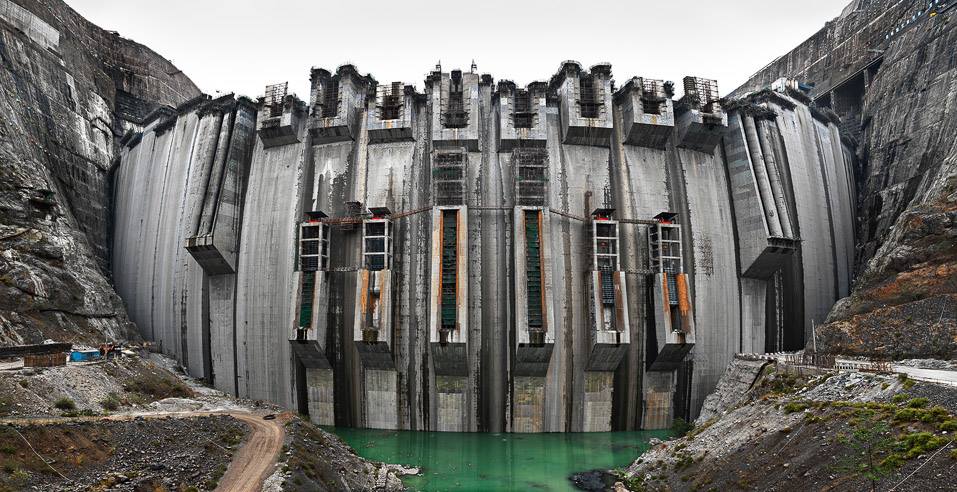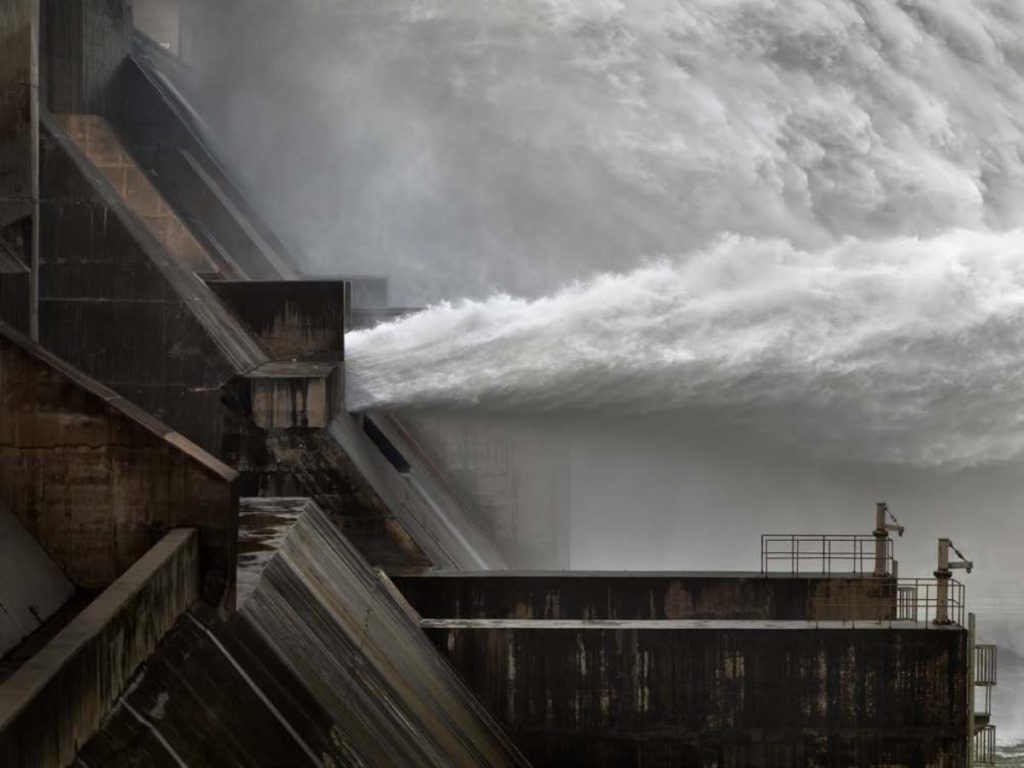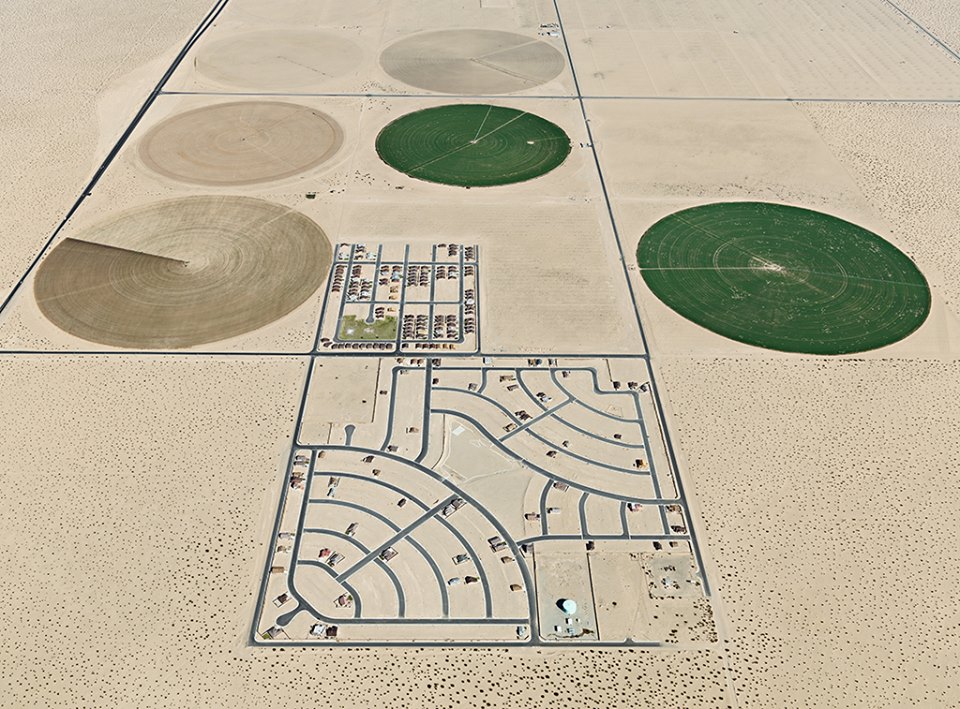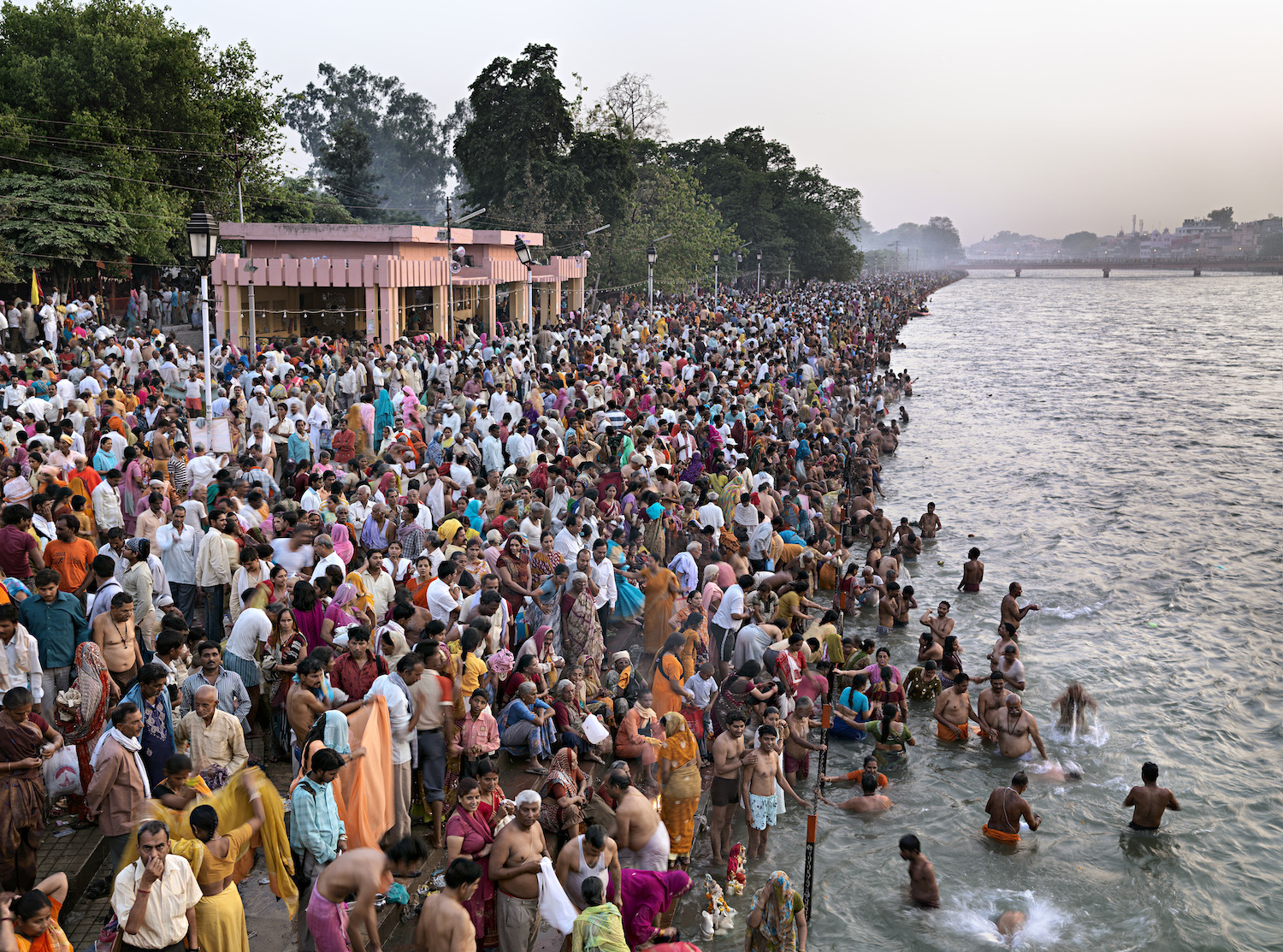Humanity has gotten too comfortable in its industrially manufactured lifestyle. “Finite” and “sufficient” are no longer in our vocabulary; we now focus on words like “effectiveness,” “expansion” and “growth”—at all costs. When we are forced by reality to leave our language-protected shell, it may already be too late to reverse the damage that’s been done. Jennifer Baichwal and Edward Burtynski, award-winning Canadian artists, are re-teaming to once again focus on something seemingly invisible, but indispensable, obvious, yet scarce, plain but endowed with magical powers: water.
Baichwal and Burtynski had already collaborated (along with Nick de Pencier) on another feature documentary ranging over the environment, widely acclaimed Manufactured Landscapes in 2006. Here they return to the subject of industrial short-sightedness in the abuse of nature. In Watermark the filmmaker-photographer duo travels to the Chinese Xiluodu Dam, six times the size of the Hoover, the leather tanneries of Dhaka marking the Ganges with their dirty trail and all the way to barren desert of Colorado River delta. They witness 30 million people gathering for a sacred bath at Kumbh Mela in Allahabad and discover the icy waters floating two kilometers under the Greenland Ice Sheet. All to track uses and abuses, meaning and power of water all around the globe. The effect of their incredible journey—and the one-year editing process—is technically flawless and masterfully executed, combining still photography and film, including startling aerial shots. I met Baichwal and Burtynski in Berlin, where Watermark had its European premiere, and talked about carbon spewing, the sublime, industrial combustion engine and the future of humanity. Watermark recently opened theatrically.
Keyframe: How was it to re-team after Manufacturing Landscapes and how did the idea of Watermark come to life?
Edward Burtynski: Jennifer and I quite enjoyed working together on Manufactured Landscapes. We seemed to share a lot of values and ideas about what’s happening on our planet. So we always wanted to work together again. I was doing a project on oil and we started to talk about that, but I was just starting a research on water, which I saw as an even more important liquid than oil. We can kind of adjust for reduction of oil, work around it. But not water. Australia was the place where I began to understand it. I live in Canada, around Lake Ontario. The Great Lakes are twenty percent of the world’s known fresh water available. Water was not in trouble where I was from, other than pollution and such things. But in Australia the water’s so critical. I spent couple of years working on different ways I could begin to think about water and how we, as humans use it, sometimes abuse it. Two years into it I invited Jennifer into the idea to collaborate. I brought the kind of ideas and the bigger themes, the dams, the Colorado River in California, I was kind of already working with all of that, and Jennifer would bring out the stories, try to give it more ethos and empathy for what happened to people in those landscapes, what’s going on there. The combination of the locations and how to talk about water visually and then her ability to bring the stories together with that, is how we decided to co-direct. We played to each other strengths.
Keyframe: You traveled around the world to shoot Watermark. How did you pick locations and determine the narrative construction?
Jennifer Baichwal: It’s not a conventional narrative in the sense that it doesn’t follow a storyline. I sometimes think that documentaries force that as a way to be more like narrative films. And it is also not a conventional documentary in the sense that it’s not advancing a particular argument. There’s a lack of didactic content in the film very much on purpose. We had hundreds of pictures on a big wall that all represented different places and different ways of humans interacting with water, and they were organized loosely around those categories that Ed developed for his book: ‘distress,’ ‘control,’ ‘agriculture,’ ‘aquaculture,’ ‘waterfront’ and ‘source.’ We started there, but you make a rule to break it. As soon as we started categorizing according to those sections it became very clear that the film couldn’t go that way, that it would create a rigidity that did not suit the subject. The idea was to create a rhythm that was a bit like a river where the juxtaposition of stories was more about how they illuminated each other rather than a narrative march from a beginning to a conclusion. So it’s more of an essay I would say, more philosophically based that narratively based.
Keyframe: Despite their diversity you managed to give each story enough exposure.
Baichwal: Each story had to be iconic in a certain kind of interaction, and often it’s the biggest. Kumbha Mela is the biggest gathering of people on the planet but also an example of a spiritual relationship with water or longing to be near water. What the Ganges represents to all of those Hindus is the idea of hopefulness or being able to wash away your sins. That was a very profound moment. It also seemed to stand in for baptism and spiritual relationships with water everywhere. Dhaka became a symbol for industrial water and was very specifically that, because we wanted to focus on a place where the light gets shone back on us. The [leather] tanners are there because we don’t have them in the developed world anymore—they are too dirty for our standards! We outsource them to places like that. All of this leather they tan is for export. When you look at that sludge going down the river and then the father washing his son’s face in the same stream…. we have a direct connection to that in some way. So I wanted to make sure that, a bit like in Manufactured Landscapes, when you’re witnessing something you’re responsible for but would never normally see, it may shift your consciousness in some way. That’s how the stories got picked. And then putting them together… The editing took a year. Ed did a bit more heavy lifting in the beginning, in terms of initial research, and I did heavy lifting at the end, because I was the co-editor. It was really hard to do it with twenty different threads.
Keyframe: In the film still photography and cinematography are married into a seamless structure. Where did this idea come from?
Burtynski: The making of the book and all those stills—it was kind of a thread. And then all the beads of different stories were kind of dropped onto that thread. Because there’s a lot of stories for a motion picture, we take you to ten different countries and tell twenty different stories. You’re being woven into all those different places. All of a sudden you’re in Bangladesh, Dhaka, Los Angeles, Las Vegas… you’re constantly bouncing around. So the stills help to pin down the work that is ultimately following the authoring material for the film that is the making of the book. Same goes for the Manufactured Landscapes: it is anchored by the fact that I am looking at the world through these images and the camera’s just extending the context. This is in a way a very similar film to that.
Keyframe: I think it’s interesting that the places you picked—except for Las Vegas, which has always seemed to me like a monument raised in the name of human hubris—seemed to be very different from our Western everyday world. However there is a very tangible link here. If you think about water pollution in United States there was another spill, just a few weeks ago. Did you ever think about using one of the more familiar locations?
Baichwal: We thought about that a lot… the stories were about sixty that became twenty. And we probably shot about twenty five. It was obvious that we should do something about the tar sands, because Canada and the tar sands use enormous amount of water. It was winter, everything was frozen, they were scared to death, nobody would agree to shoot with us. And a friend of ours, Peter Mettler, who shot Manufactured Landscapes, he’s just done a film with the Greenpeace called Petropolis—aerial perspectives on the tar sands. It’s a short film but all helicopter footage with his voiceover of what looks like a post-apocalyptic landscape…so, he just did that. I did a story on oil spills called Payback, where it became an example of environmental debt. We shot with Ed from a helicopter right after the spill. I guess the issue is when you tip over to journalism or into a more conventional approach, when you start to preach, you lose people. So I feel like the experiential approach where you’re invited into [an unknown] place… that invitation to spend time in that space can change you.
Keyframe: I think one of the most important themes of you film is the growing misunderstanding between humans and nature. It feels like capitalism and consumerism push this. How do you feel about that?
Burtynski: I think it actually started earlier than that and it’s even built in the religion, Christianity in particular. The thought that you name something and it’s yours… As if nature was created by God for our consumption. It is very different than when Christopher Columbus landed in North America—the first nations that were there didn’t think like that at all. They were a part of the ecosystem, another living mammal within it although more sophisticated and respectful and understanding the importance of not taking all the fish out of the lake, they knew that. They rotated. They didn’t stay too long in one place and they weren’t allowed to because, basically, nature wouldn’t support them. But I think capitalism and the industrial revolution, which is at the core of market capitalism, and the real gearing up of industry and then the internal combustion engine, then what happened to farming…it used to be that two adults working in the field could support themselves and other two other people. Now two people on big enough combines can make enough food for tens of thousands. That revolution helped humanity to begin to expand, transportation evolved, all these calories, so we were able to kind of proliferate in the energy envelope allowable through discovery of oil, coal and then natural gas; then the internal combustion engine and farming and transportation… It’s now moved us to 7 billion—and growing. I think if we hadn’t discovered the internal combustion engine and oil, we’d still be two, three billion max. When I was born there was about 2.5 billion, at the beginning of the century there was about 1.5….now we’re 7. It’s almost a billion a decade. Something is happening. And if you look at mammalian biomass, cattle are number one, I think it’s 700,000 million tons of beef, and then human beings are the second, around 350,000 million tons.
Keyframe: All the industrial investments resulting from technical advancement are supposed to facilitate human existence, but in fact they seem to be violating the natural order, a human order.
Baichwal: It feels like….Remember how they talked about how ‘the sublime’ used to be in nature, how we were scared of it because of its force. And we had this sort of numinous experience of terrible things, like earthquakes, floods, storms… And now we dwarf nature in what we do; the Xiluodu Dam [in China] is a perfect example. When you see an incursion at that level, which is so vast, it’s hard to even grasp… it’s six times bigger than the Hoover Dam! I guess when we say ‘To violate the natural order’ it’s complicated, because we ARE part of nature. We act as if we’re not, but we are…and yet the things that we do now have become the new ‘sublime’ in some way…Being on that dam what was interesting for me. There’s no black or white, right or wrong here. The Chinese need power. Why? Because they are still the manufacturers of stuff the we use everyday. But also hydropower for China is clean power, compared to coal. They’re investing in hydro projects because they’re trying to find an alternative to lessen air pollution. What was fascinating was the complexity, the ambiguity of that place. As well as the skill of the incursion. I don’t have a clear judgment of any of those vast industrial sites that we’ve visited. But I feel humility in nature, I feel it up in the sacred head waters, in the totally pristine landscape that has nothing to do with me or humans at all. People have never stepped in that ecosystem. That humility that I feel, it is true, that when I stand on the dam, it’s more like a horror. It feels like we’re really pushing it here in terms of the level of our manipulation.
Keyframe: Isn’t it a paradox: a film about degradation of nature is weirdly, but strikingly beautiful. How do you maintain the balance, not to lose the power and the message in this beauty?
Burtynski: I think sometime it’s hard for the images not to fall into that spot. If you take one of my pictures out of context and put it on that wall without an explanation, yeah, I can see that becoming totally detached…somebody once referred to it as ‘eco-porn’, or something like that…But in the context, if you look at the books that I do, it contextualizes it and I think that’s where the work really gathers its strength, its power. For me it’s important that if consciousness is going to start to shift I don’t think it works as well if you become to political or polemic or opinionated. When you’re looking at material and the meaning is a floating point, it’s not a fixed meaning, it’s more dynamic. One day it might mean just the esthetic thing if you are looking at that picture. But the next day you’ll think ‘It’s amazing that this is what we’re doing to our landscape,’ because you approach it from the context side. I think that these are multiple entry levels into work. It doesn’t say right or wrong, you can read it at different levels. Opening up those readings and letting people enter it and own the kinds of opinions and thoughts that this work brings forward, I think, has a more lasting and powerful chance at letting people become more conscious about what we’re doing out there.
Keyframe: Your film shows the present reality but seems at times like a vision of a dystopian future. It’s also because of the sound design, very atmospheric.
Baichwal: The music over the dam especially, that Roland Schlimme, our editor, composed, is really is dark, heavy. My mother listened to it and said: ‘That sounds like someone’s been assaulted in a dungeon!’ I was a bit worried about that. We ended up pulling back on that music quite a lot because I didn’t want it to feel like the dark satanic mills, you know…On the other hand I wanted the music to emerge out of the industrial soundscape. The density of sound in a place like that is unbelievable. Loud, varied, overwhelming, just the sound makes you exhausted. We recorded a lot of that so that we could work with it. We were very suspicious of using music as an emotional tool in general. I hate it when it’s done, particularly in documentary. I don’t even like it in dramatic films, I feel manipulated. And in documentary it’s even worse when you have a poignant moment that is backed up by a swollen score…Scores always sound like scores in documentaries. Us, normally, we start with a composer at the stage of research and as soon as we’re shooting footage we give them that footage to work with and start. It’s a collaborative process from the beginning because otherwise it would be like a one-sided conversation.
Keyframe: Edward, I know that asking an artist about being inspired by other artists is always tricky, but there’ve been many documentaries dealing with the abuse of nature recently, focused around the subject of water—Last Call at the Oasis, Last Ocean, The End of The Line, Sea the Truth… Then visually Watermark sometimes reminds me of Glawogger because of its stillness…
Burtynski: There is a movie I saw, called Our Daily Bread and to me that was really well done. Very simple, but powerful. And again letting the visuals not having to say much, just show it is very interesting. I’ve liked some of the experimentalism of the Ron Fricke’s Samsara. He did Baraka before. This kind of excursions into the visual and the music…there are several different approaches I’ve taken, but I wouldn’t do a nonverbal film. Words are too important. Telling just enough without having the narrator, that disembodied Voice of God or whatever that’s telling you what you’re looking at…That can work too but is not that compelling. Allowing the subject to tell the story is more compelling.
Keyframe: You do that. And very often the images in your film look very alien. You show places where the objects of daily life often come from, but we don’t know that.
Burtynski: It’s easier not to know, the guilt doesn’t well up.
Keyframe: You wanted to expose our indifference?
Burtynski: And reconnect us. In a way all my work is about reconnecting us to the places we partake of every day. We get metal, copper, tin and silver from mines and then all of the marble quarries, granite quarries…I went to look at the industrial revolution in China, how we take those raw materials and convert them into the things we consume. It’s always been about going back to our kind of dangerous relationship with nature, a cover we’re opening, go inside and just take whatever we want without real regard. You can see what we are doing to the oceans. Now we’re at ten percent of the large fish left, ninety percent gone. And oceans are big places! I don’t know if you’ve noticed flying over, but that’s a lot to fish…[Laughs.] It’s ridiculous. Deforestation, the Amazon, cutting down the rainforests to grow palm oil…A lot of it it’s being used to create fuel, you know? So we have the machinery and enough intelligence to go there and reap what nature can provide, but do we have the intelligence to know when to stop?
Baichwal: On the other hand we’re totally implicated in everything that we’re filming. We traveled all over the world. And our film is totally offset, whatever that really means. I feel like that’s a bit of a Bandaid frankly, but at least we did that. We offset the whole production and post production. But the carbon spewing as we traveled around the world… Include that in your own implication. Is it worth it? Sometimes I think it’s not. If i just stayed at home and read I would have much more less impact on the world! [Laughs.] The consciousness…Even though I’ve been in places that really made me fearful for the future, I feel like increasing the depth of knowledge takes me further. And I don’t wanna avert my gaze. Knowing is better that not knowing. The hopefulness that comes from really engaging with a place and people…it’s impossible to not be emphatically engaged. And that in itself is hopeful, that we have this capacity as humans to really meet another human.
Keyframe: Have you had experiences like that when shooting Watermark?
Baichwal: The boy in a pink hat on the rice paddy. He looked exactly like that when we first saw him, like from a Miyazaki film…and was as curious about us as we were about him. So we spent the whole next day with him and his family. And that was very meaningful. Those things carry through. Also with water it’s very interesting to see how quickly the landscape remediates itself when the water is allowed back. It happened by accident in the Colorado River Delta: there was this little accidental agricultural wastewater run off from Arizona, crap water that went there. And almost overnight it transformed into a wetland. the grass grew back, the birds returned, the fish…We can see what can be done with such a little amount of water. That became a model for all these groups that are now working there to restore this small regions. Their optimism is humbling, inspiring…It’s hope.
Keyframe: Hoping that some politicians are good people…
Baichwal: [Laughs.]
Keyframe: … It is very complicated position to be in. On one hand you have to care about growth, expansion, being faster, more effective…on the other hand you cannot miss things you and other filmmakers are talking about. Have you had any contact with such people?
Baichwal: Decision makers don’t really listen to people like us. That’s another reason why the film’s not conventionally didactic or polemical. More people will see this and be possibly provoked by it than if it was a straight-on…There’s a film called Water Wars—such films are necessary, but….You know what you’re getting yourself into. It’s sort of like preaching to the converted. If somebody agrees with you they’re gonna fire up, if not—they’ll walk out. That’s a binary thing. I live in a country where the government is so right wing in terms of its focus on economics at all cost that any science that is theoretical and independent is attacked, the only science that is being supported is the science that can be applied towards economical growth. It’s mind-boggling that we don’t have more political will in this country to see that this is not the way to go. So I feel it will start changing only when things start to fall apart and become really scary. When that happens people will respond.
Keyframe: …But it might be too late.
Baichwal: I know. You’re right. But then we don’t deserve to survive as a species. I don’t have any sentimentality about that. If we can’t figure it out….We’ve proliferated. We’ve expanded and will till our maximum allowable footprint—and then we contract. When there’s no longer conditions sustainable for life. I’m not saying I want that to happen—I don’t, that’s why I make films like this. But if we can’t figure it out….We don’t deserve it.








